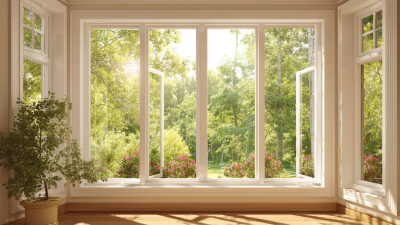Innovative Examples of Energy Efficient Windows Transforming Home Energy Performance
As the world increasingly shifts towards sustainable living, the importance of energy efficient windows cannot be overstated. These innovative designs not only enhance the aesthetic appeal of homes but also play a pivotal role in transforming energy performance. With advancements in technology and materials, energy efficient windows are becoming a cornerstone in reducing energy consumption and minimizing utility bills, while contributing to a healthier environment. In this blog, we will explore various innovative examples of energy efficient windows that are setting new standards for home energy performance. From cutting-edge glazing techniques to the integration of smart technologies, these windows are not just functional; they are the future of home design, leading the charge toward a sustainable lifestyle. Join us as we delve into how these remarkable innovations can significantly impact energy efficiency and overall comfort in our living spaces.

Table of Contents
[Hide]
Innovative Technologies Behind Energy Efficient Windows and Their Benefits
Innovative technologies in energy-efficient windows are revolutionizing residential energy performance. Modern materials like low-emissivity (low-E) glass reflect heat while allowing natural light to enter, reducing the need for artificial heating and cooling. These windows are often treated with special coatings that minimize solar heat gain, helping to regulate indoor temperatures throughout different seasons. Such advancements not only improve comfort but also lead to significant savings on energy bills over time.

Another cutting-edge development in window technology is the integration of smart glazing systems. These windows can adjust their tint based on sunlight and heat exposure, optimizing energy use dynamically. Additionally, triple-pane designs with gas-filled spaces between layers provide superior insulation compared to traditional double-pane windows. As homeowners become more environmentally conscious, investing in these innovative window solutions not only enhances energy efficiency but also contributes to a sustainable future by lowering carbon footprints and promoting greener living spaces.
Key Performance Metrics: Understanding U-Factor and Solar Heat Gain Coefficient
When it comes to enhancing home energy performance, understanding key metrics like U-Factor and Solar Heat Gain Coefficient (SHGC) is essential. The U-Factor measures how well a window insulates against heat loss. The lower the U-Factor, the better a window is at keeping your home warm during cold months while reducing energy bills. For homeowners in colder climates, choosing windows with a low U-Factor can significantly improve energy efficiency and overall comfort.
On the other hand, the Solar Heat Gain Coefficient determines how well a window blocks heat from sunlight. A lower SHGC means less solar heat enters your home, making it ideal for warmer climates where excessive heat can lead to increased cooling costs. Homeowners should consider the orientation of their windows and local climate when selecting the appropriate SHGC for their needs.
Tips: When shopping for windows, always request and compare the U-Factor and SHGC ratings from manufacturers to ensure you’re making an informed decision. Additionally, consider the use of low-emissivity (low-e) coatings on glass, which can enhance insulation and reduce solar heat gain, thus improving energy efficiency throughout the year. Finally, proper installation can maximize these benefits, so always work with qualified professionals to achieve optimal performance.
Energy Efficiency Metrics of Innovative Windows
This chart illustrates the U-Factor and Solar Heat Gain Coefficient (SHGC) of different energy-efficient window types, showcasing their impact on home energy performance.
Impact of Energy Efficient Windows on Home Energy Consumption and Cost Savings
Energy-efficient windows are revolutionizing the way we think about home energy consumption and cost savings. By incorporating advanced technologies such as Low-E coatings and triple glazing, these windows significantly reduce heat loss in winter and minimize heat gain in summer. This leads to more stable indoor temperatures, reducing the reliance on heating and cooling systems. As a result, homeowners can experience substantial reductions in energy bills, often saving hundreds of dollars each year.
Moreover, the impact of energy-efficient windows extends beyond just the financial aspects. With improved insulation and the ability to filter harmful UV rays, these windows not only enhance comfort but also protect furnishings and flooring from premature fading. In states where energy needs are particularly high due to extreme temperatures, the installation of such windows contributes to a more sustainable future by decreasing energy demand and lowering greenhouse gas emissions. As awareness grows, more homeowners are recognizing the long-term benefits of investing in energy-efficient windows, making it a pivotal choice in the pursuit of energy savings and environmental responsibility.
Innovative Examples of Energy Efficient Windows Transforming Home Energy Performance
| Window Type | U-Value (W/m²K) | Solar Heat Gain Coefficient (SHGC) | Annual Energy Savings ($) | Return on Investment (Years) |
|---|---|---|---|---|
| Double Glazed Low-E | 1.2 | 0.30 | $120 | 5 |
| Triple Glazed | 0.8 | 0.25 | $200 | 7 |
| Double Glazed Argon Gas | 1.0 | 0.28 | $150 | 6 |
| Energy Star Certified | 1.1 | 0.32 | $130 | 5.5 |
Case Studies: Real-World Applications of Energy Efficient Windows in Residential Settings
 Energy-efficient windows have become a crucial component in enhancing home energy performance, and numerous case studies highlight their transformative impact in residential settings. One notable example is a retrofit project in a suburban home in California, where the installation of low-emissivity (Low-E) glass windows resulted in a significant reduction in energy usage. The homeowners reported a decrease in heating and cooling costs by approximately 30%, attributed to better insulation and minimized heat transfer. This case illustrates not only the immediate financial benefits of energy-efficient windows but also their role in promoting sustainable living.
Energy-efficient windows have become a crucial component in enhancing home energy performance, and numerous case studies highlight their transformative impact in residential settings. One notable example is a retrofit project in a suburban home in California, where the installation of low-emissivity (Low-E) glass windows resulted in a significant reduction in energy usage. The homeowners reported a decrease in heating and cooling costs by approximately 30%, attributed to better insulation and minimized heat transfer. This case illustrates not only the immediate financial benefits of energy-efficient windows but also their role in promoting sustainable living.
Another impressive example can be found in a multi-family building in New York City, where the use of triple-glazed windows led to remarkable improvements in energy efficiency. The design addressed urban noise and extreme weather conditions, making the living environment more comfortable for residents. Post-installation energy audits showed a reduction in overall energy consumption by 20%, proving that energy-efficient windows can play a pivotal role in urban residential designs. These real-world applications exemplify how innovative materials and technologies in window manufacturing can lead to substantial energy savings and enhance the overall performance of homes in diverse climates.
Future Trends: Advancements in Window Technology for Enhanced Energy Efficiency
As we move towards a more energy-conscious future, advancements in window technology are leading the charge in enhancing energy efficiency for homes. The emergence of smart glass, for instance, allows homeowners to control the amount of light and heat entering their spaces. This type of window can automatically adjust its tint based on sunlight levels, significantly reducing the need for artificial cooling or heating. By integrating solar control features, smart windows not only help in maintaining comfort but also contribute to lower energy bills and reduced environmental impact.
Additionally, the development of triple-glazed windows offers improved insulation compared to traditional double-pane units. These advanced windows are designed with multiple layers of glass separated by insulating gas, which minimizes heat transfer and enhances overall thermal performance. Energy-efficient coatings applied to these windows can further reflect solar energy, keeping homes cooler in the summer and warmer in the winter. As window technology continues to evolve, we can expect these innovations to play a pivotal role in transforming residences into more sustainable and energy-efficient spaces.
Related Posts
-

7 Secrets to Choosing the Best Energy Efficient Windows for Your Home
-

Innovative Designs for Doors and Windows That Transform Spaces Globally
-

Ultimate Guide to Choosing the Perfect House Windows for Your Home
-

Issues Faced When Choosing Residential Doors and Windows for Your Home
-

Innovative Examples of Interior Doors Transforming Modern Spaces with Industry Insights
-

Exploring Unique Alternatives to Traditional Big Windows for Modern Spaces